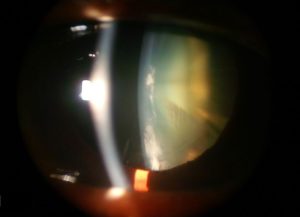There are Three Common Types of Cataract
Ophthalmologists categorize cataracts in different ways. The most basic method of classification is according to the location of the actual opacity (cataract).
There are actually different kinds of cataracts. Three of the most common types of cataracts are related to the aging eye.
Nuclear cataract
A nuclear cataract is the most common type of age-related cataract. It is caused by the hardening and discoloration (yellowing) of the lens. This type of cataract forms deep in the central area, or nucleus of the lens.
Over time, this type of cataract changes the eye’s ability to focus. Close-up vision needed for reading and other types of close work might actually improve temporarily. This change is not permanent and as time goes on, the cataract slowly affects vision in an adverse way.
These types of cataracts develop slowly and take years before they begin to affect vision.
Posterior subcapsular cataract
A posterior subcapsular cataract develops at the back of the lens, as the name implies. This type of cataract is called subcapsular because it forms under the lens capsule. This capsule is a thin membrane that surround the lens and helps hold it in place. With this type of cataract, a person may see a “halo” and glare around lights.
Extreme nearsightedness, diabetes, or taking high doses of steroid medications are risk factors for developing this type of cataract. Posterior subcapsular cataracts tend to develop quickly and the effects are noticed within months.
Cortical cataract
A cortical cataract is characterized by white, wedge-shaped cloudiness that starts in the outer edges of the body of the lens, and they grow toward the center in a spoke-like.
These spokes, or fissures, can cause the light that enters the eye to scatter. This scattering causes blurred vision, glare, and difficulty in noticing contrast. People with diabetes are at a higher risk for developing cortical cataracts.

